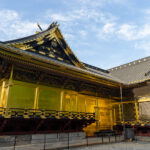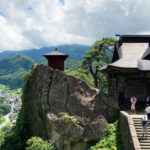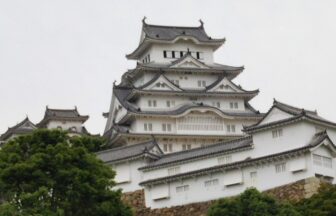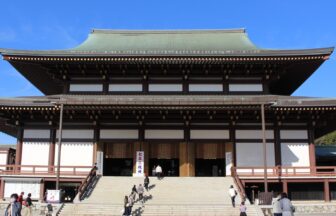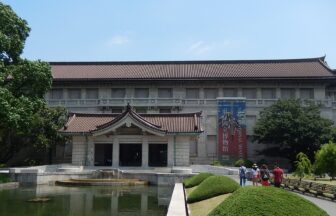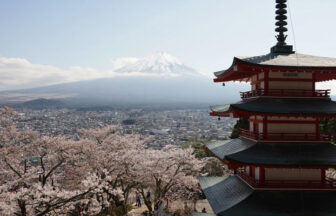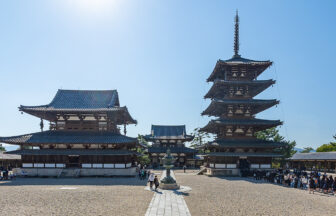Shinshoji temple in Narita city is one of the biggest Buddhist temples in Japan. In this huge temple complex, there are many cultural properties including five traditional buildings designated as national cultural properties.
1. Important cultural properties
The large temple precinct, about 200,000 ㎡, contains over twenty historical architectures.
1.1 National Important cultural properties
There are five buildings designated as national important cultural properties.
(1) Komyodo hall(光明堂)
This oldest building was built in 1701 and used to be the main hall until mid 19th century. There are some old Buddhist statues including Aizome Myoo which is believed to help visitors find a partner.
(2) Niomon gate(仁王門)
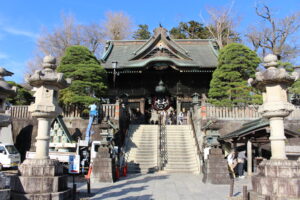
Niomon gate stands on the steep slope in front of the main hall. This traditional structure decorated with wooden carvings was constructed in 1831. In side of the gate there are four statues of guardian gods which protect the temple from evil splits.
(3) Three storied pagoda(三重塔)

It was built in 1712 as a symbol of a Buddhist temple. There are many heads of dragons on roofs to protect the pagoda from firing because dragons have been believed to be a god of water. It enshrines a Gochi Nyorai Buddha statue.
(4) Shakado hall(釈迦堂)
This building was built in 1858 and used to be the former main hall. It is now used as a place to pray for warding off evil. It has many sculptures on walls and ceilings.
(5) Gakudo hall (額堂)
This building is a place to display sums and votive tablets which were dedicated by ancient visitors. It was built in 1861.
1.2 Other traditional buildings
(1) Main hall(本堂)
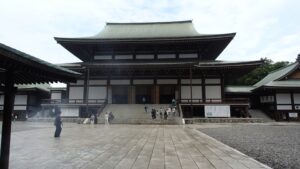
Main hall in which the principal deity, Fudomyo-o is enshrined. The fire ritual called Goma ceremony has been conducted by monks several times a day from ancient times.
(2) Somon or Main gate (総門)
It is 15m high and all made of zelkova, a kind of tree in the elm family called Keyaki in Japanese.
(3) Great Pagoda of Peace (平和大塔)
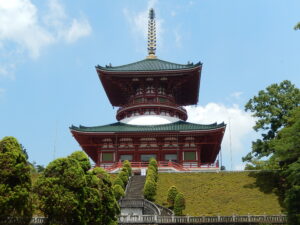
1.3 Fudo-myoo (不動明王) statue
Shinshoji temple enshrines Fudo-myoo which is one of the important deities of Japanese Buddhism. His statue can be seen in so many places in Japan that it’s not uncommon to find one near a waterfall or simply by a mountain path.
Fudo-myoo literally means “The immovable wisdom king”. He is the guardian of Buddhism and one of the five Wisdom kings along with Gozanze, Gundari, Daiitoku and Kongoyasha.
He has a scary appearance to be able to frighten people into accepting the salvation brought by Dainichi-Nyorai. He also battles evil with his immovable faith and his compassion.
2. Origin of the temple
■ 810: Kukai carved an image of Fudomyo (不動明王)
The Naritasan Shinshoji belongs to the Shingon sect of Buddhism. A famous priest called Kukai established the Shingon sect in the Heian period, 9th century. He went to China and he was initiated into esoteric Buddhism, and brought back esoteric teachings to Japan. Then he founded the Shingon school of Buddhism in Kyoto.
The image of Fudomyo is a valuable piece of sculpture made by Kukai by order of Emperor Saga. Kukai carved the image of Fudomyo in such a manner that for each line he chiseled, he prayed three times.
■ 939: The war of Taira no Masakado(平将門の乱)
Taira no Masakado, a samurai in Kanto which is the region including the greater Tokyo area of the eastern Japan, led a rebellion against the imperial court of Kyoto as he referred to himself as the new emperor.
In the age of provincial wars, people lived in constant fear and confusion. At the Imperial Court, Emperor Suzaku, who hoped for an immediate end to the rebellion, ordered Kancho, a Buddhist priest of the highest order, to take the image of Fudo-myo made by Kukai to the battlefield to suppress the rebellion. He sailed by ship from Osaka to Boso peninsula.
■ 940: Foundation of Naritasan (成田山の始まり)
The great priest Kancho enshrined the image of Fudo-myo in Narita and prayed for the end of the rebellion by burning goma, which are small pieces of wood on the altar to invoke divine help. On the last day of the goma ceremony, Taira no Masakado was defeated and peace prevailed in the country.
The great priest Kancho decided to go back to Kyoto, but the image of Fudo-myoo would not move. The image suddenly opened its mouth and said that Kancho should stay in Narita and save people there. This mysterious happening is the origin of Naritasan.
This 58m tall pagoda symbolizes the Shingon sect of Buddhism in Japan. Visitors can transcribe scriptures with a brush or pen on the first floor. This practice of tracing Buddhist teachings by brush is a part of a monk’s religious training.
3. Access
・15 minutes walk from JR Narita station and Keise Narita station
・JR and Keisei Narita stations are located about one hour from central Tokyo.
・JR and Keisei Narita stations are 10 minutes from Narita airport by train.
4. Related blog
“Sightseeing Spots of Naritasan Shishoji Temple” by Eddy Murayama
■ Contact
If you have any feedback, please fill in the following. Your message will be sent to the author “Eddy Murayama”. Thank you so much for your visit to the site.


